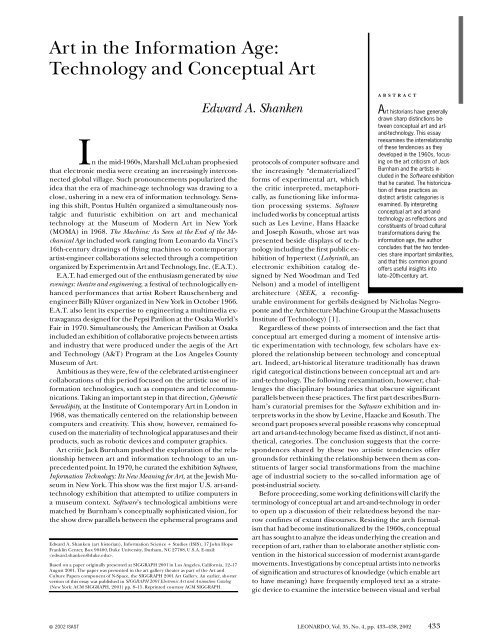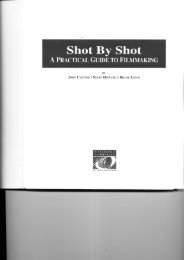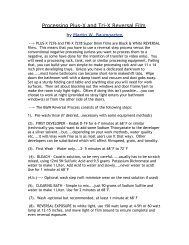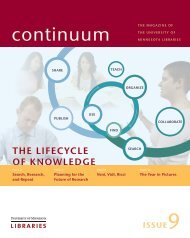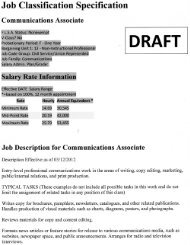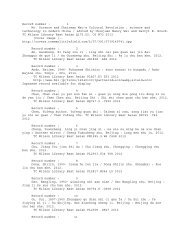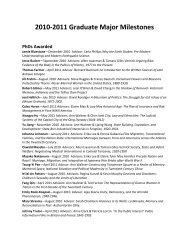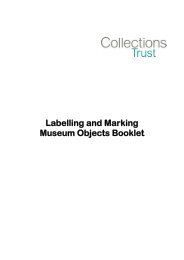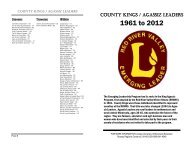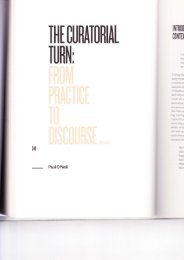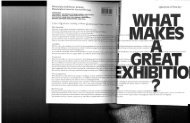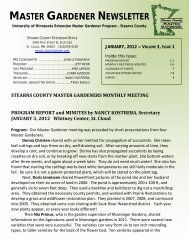Art in the Information Age: Technology and Conceptual Art
Art in the Information Age: Technology and Conceptual Art
Art in the Information Age: Technology and Conceptual Art
You also want an ePaper? Increase the reach of your titles
YUMPU automatically turns print PDFs into web optimized ePapers that Google loves.
<strong>Art</strong> <strong>in</strong> <strong>the</strong> <strong>Information</strong> <strong>Age</strong>:<br />
<strong>Technology</strong> <strong>and</strong> <strong>Conceptual</strong> <strong>Art</strong><br />
In <strong>the</strong> mid-1960s, Marshall McLuhan prophesied<br />
that electronic media were creat<strong>in</strong>g an <strong>in</strong>creas<strong>in</strong>gly <strong>in</strong>terconnected<br />
global village. Such pronouncements popularized <strong>the</strong><br />
idea that <strong>the</strong> era of mach<strong>in</strong>e-age technology was draw<strong>in</strong>g to a<br />
close, usher<strong>in</strong>g <strong>in</strong> a new era of <strong>in</strong>formation technology. Sens<strong>in</strong>g<br />
this shift, Pontus Hultén organized a simultaneously nostalgic<br />
<strong>and</strong> futuristic exhibition on art <strong>and</strong> mechanical<br />
technology at <strong>the</strong> Museum of Modern <strong>Art</strong> <strong>in</strong> New York<br />
(MOMA) <strong>in</strong> 1968. The Mach<strong>in</strong>e: As Seen at <strong>the</strong> End of <strong>the</strong> Mechanical<br />
<strong>Age</strong> <strong>in</strong>cluded work rang<strong>in</strong>g from Leonardo da V<strong>in</strong>ci’s<br />
16th-century draw<strong>in</strong>gs of y<strong>in</strong>g mach<strong>in</strong>es to contemporary<br />
artist-eng<strong>in</strong>eer collaborations selected through a competition<br />
organized by Experiments <strong>in</strong> <strong>Art</strong> <strong>and</strong> <strong>Technology</strong>, Inc. (E.A.T.).<br />
E.A.T. had emerged out of <strong>the</strong> enthusiasm generated by n<strong>in</strong>e<br />
even<strong>in</strong>gs: <strong>the</strong>atre <strong>and</strong> eng<strong>in</strong>eer<strong>in</strong>g, a festival of technologically enhanced<br />
performances that artist Robert Rauschenberg <strong>and</strong><br />
eng<strong>in</strong>eer Billy Klüver organized <strong>in</strong> New York <strong>in</strong> October 1966.<br />
E.A.T. also lent its expertise to eng<strong>in</strong>eer<strong>in</strong>g a multimedia extravaganza<br />
designed for <strong>the</strong> Pepsi Pavilion at <strong>the</strong> Osaka World’s<br />
Fair <strong>in</strong> 1970. Simultaneously, <strong>the</strong> American Pavilion at Osaka<br />
<strong>in</strong>cluded an exhibition of collaborative projects between artists<br />
<strong>and</strong> <strong>in</strong>dustry that were produced under <strong>the</strong> aegis of <strong>the</strong> <strong>Art</strong><br />
<strong>and</strong> <strong>Technology</strong> (A&T) Program at <strong>the</strong> Los Angeles County<br />
Museum of <strong>Art</strong>.<br />
Ambitious as <strong>the</strong>y were, few of <strong>the</strong> celebrated artist-eng<strong>in</strong>eer<br />
collaborations of this period focused on <strong>the</strong> artistic use of <strong>in</strong>formation<br />
technologies, such as computers <strong>and</strong> telecommunications.<br />
Tak<strong>in</strong>g an important step <strong>in</strong> that direction, Cybernetic<br />
Serendipity, at <strong>the</strong> Institute of Contemporary <strong>Art</strong> <strong>in</strong> London <strong>in</strong><br />
1968, was <strong>the</strong>matically centered on <strong>the</strong> relationship between<br />
computers <strong>and</strong> creativity. This show, however, rema<strong>in</strong>ed focused<br />
on <strong>the</strong> materiality of technological apparatuses <strong>and</strong> <strong>the</strong>ir<br />
products, such as robotic devices <strong>and</strong> computer graphics.<br />
<strong>Art</strong> critic Jack Burnham pushed <strong>the</strong> exploration of <strong>the</strong> relationship<br />
between art <strong>and</strong> <strong>in</strong>formation technology to an unprecedented<br />
po<strong>in</strong>t. In 1970, he curated <strong>the</strong> exhibition Software,<br />
<strong>Information</strong> <strong>Technology</strong>: Its New Mean<strong>in</strong>g for <strong>Art</strong>, at <strong>the</strong> Jewish Museum<br />
<strong>in</strong> New York. This show was <strong>the</strong> rst major U.S. art-<strong>and</strong>technology<br />
exhibition that attempted to utilize computers <strong>in</strong><br />
a museum context. Software’s technological ambitions were<br />
matched by Burnham’s conceptually sophisticated vision, for<br />
<strong>the</strong> show drew parallels between <strong>the</strong> ephemeral programs <strong>and</strong><br />
Edward A. Shanken (art historian), <strong>Information</strong> Science 1 Studies (ISIS), 17 John Hope<br />
Frankl<strong>in</strong> Center, Box 90400, Duke University, Durham, NC 27708, U.S.A. E-mail:<br />
.<br />
Based on a paper orig<strong>in</strong>ally presented at SIGGRAPH 2001 <strong>in</strong> Los Angeles, California, 12–17<br />
August 2001. The paper was presented <strong>in</strong> <strong>the</strong> art gallery <strong>the</strong>ater as part of <strong>the</strong> <strong>Art</strong> <strong>and</strong><br />
Culture Papers component of N-Space, <strong>the</strong> SIGGRAPH 2001 <strong>Art</strong> Gallery. An earlier, shorter<br />
version of this essay was published <strong>in</strong> SIGGRAPH 2001 Electronic <strong>Art</strong> <strong>and</strong> Animation Catalog<br />
(New York: ACM SIGGRAPH, 2001) pp. 8–15. Repr<strong>in</strong>ted courtesy ACM SIGGRAPH.<br />
Edward A. Shanken<br />
protocols of computer software <strong>and</strong><br />
<strong>the</strong> <strong>in</strong>creas<strong>in</strong>gly “dematerialized”<br />
forms of experimental art, which<br />
<strong>the</strong> critic <strong>in</strong>terpreted, metaphorically,<br />
as function<strong>in</strong>g like <strong>in</strong>formation<br />
process<strong>in</strong>g systems. Software<br />
<strong>in</strong>cluded works by conceptual artists<br />
such as Les Lev<strong>in</strong>e, Hans Haacke<br />
<strong>and</strong> Joseph Kosuth, whose art was<br />
presented beside displays of technology<br />
<strong>in</strong>clud<strong>in</strong>g <strong>the</strong> rst public exhibition<br />
of hypertext (Labyr<strong>in</strong>th, an<br />
electronic exhibition catalog designed<br />
by Ned Woodman <strong>and</strong> Ted<br />
Nelson) <strong>and</strong> a model of <strong>in</strong>telligent<br />
architecture (SEEK, a recong-<br />
A B S T R A C T<br />
<strong>Art</strong> historians have generally<br />
drawn sharp dist<strong>in</strong>ctions between<br />
conceptual art <strong>and</strong> art<strong>and</strong>-technology.<br />
This essay<br />
reexam<strong>in</strong>es <strong>the</strong> <strong>in</strong>terrelationship<br />
of <strong>the</strong>se tendencies as <strong>the</strong>y<br />
developed <strong>in</strong> <strong>the</strong> 1960s, focus<strong>in</strong>g<br />
on <strong>the</strong> art criticism of Jack<br />
Burnham <strong>and</strong> <strong>the</strong> artists <strong>in</strong>cluded<br />
<strong>in</strong> <strong>the</strong> Software exhibition<br />
that he curated. The historicization<br />
of <strong>the</strong>se practices as<br />
dist<strong>in</strong>ct artistic categories is<br />
exam<strong>in</strong>ed. By <strong>in</strong>terpret<strong>in</strong>g<br />
conceptual art <strong>and</strong> art-<strong>and</strong>technology<br />
as re¯ections <strong>and</strong><br />
constituents of broad cultural<br />
transformations dur<strong>in</strong>g <strong>the</strong><br />
<strong>in</strong>formation age, <strong>the</strong> author<br />
concludes that <strong>the</strong> two tendencies<br />
share important similarities,<br />
<strong>and</strong> that this common ground<br />
offers useful <strong>in</strong>sights <strong>in</strong>to<br />
late±20th-century art.<br />
urable environment for gerbils designed by Nicholas Negroponte<br />
<strong>and</strong> <strong>the</strong> Architecture Mach<strong>in</strong>e Group at <strong>the</strong> Massachusetts<br />
Institute of <strong>Technology</strong>) [1].<br />
Regardless of <strong>the</strong>se po<strong>in</strong>ts of <strong>in</strong>tersection <strong>and</strong> <strong>the</strong> fact that<br />
conceptual art emerged dur<strong>in</strong>g a moment of <strong>in</strong>tensive artistic<br />
experimentation with technology, few scholars have explored<br />
<strong>the</strong> relationship between technology <strong>and</strong> conceptual<br />
art. Indeed, art-historical literature traditionally has drawn<br />
rigid categorical dist<strong>in</strong>ctions between conceptual art <strong>and</strong> art<strong>and</strong>-technology.<br />
The follow<strong>in</strong>g reexam<strong>in</strong>ation, however, challenges<br />
<strong>the</strong> discipl<strong>in</strong>ary boundaries that obscure signicant<br />
parallels between <strong>the</strong>se practices. The rst part describes Burnham’s<br />
curatorial premises for <strong>the</strong> Software exhibition <strong>and</strong> <strong>in</strong>terprets<br />
works <strong>in</strong> <strong>the</strong> show by Lev<strong>in</strong>e, Haacke <strong>and</strong> Kosuth. The<br />
second part proposes several possible reasons why conceptual<br />
art <strong>and</strong> art-<strong>and</strong>-technology became xed as dist<strong>in</strong>ct, if not anti<strong>the</strong>tical,<br />
categories. The conclusion suggests that <strong>the</strong> correspondences<br />
shared by <strong>the</strong>se two artistic tendencies offer<br />
grounds for reth<strong>in</strong>k<strong>in</strong>g <strong>the</strong> relationship between <strong>the</strong>m as constituents<br />
of larger social transformations from <strong>the</strong> mach<strong>in</strong>e<br />
age of <strong>in</strong>dustrial society to <strong>the</strong> so-called <strong>in</strong>formation age of<br />
post-<strong>in</strong>dustrial society.<br />
Before proceed<strong>in</strong>g, some work<strong>in</strong>g denitions will clarify <strong>the</strong><br />
term<strong>in</strong>ology of conceptual art <strong>and</strong> art-<strong>and</strong>-technology <strong>in</strong> order<br />
to open up a discussion of <strong>the</strong>ir relatedness beyond <strong>the</strong> narrow<br />
connes of extant discourses. Resist<strong>in</strong>g <strong>the</strong> arch formalism<br />
that had become <strong>in</strong>stitutionalized by <strong>the</strong> 1960s, conceptual<br />
art has sought to analyze <strong>the</strong> ideas underly<strong>in</strong>g <strong>the</strong> creation <strong>and</strong><br />
reception of art, ra<strong>the</strong>r than to elaborate ano<strong>the</strong>r stylistic convention<br />
<strong>in</strong> <strong>the</strong> historical succession of modernist avant-garde<br />
movements. Investigations by conceptual artists <strong>in</strong>to networks<br />
of signication <strong>and</strong> structures of knowledge (which enable art<br />
to have mean<strong>in</strong>g) have frequently employed text as a strategic<br />
device to exam<strong>in</strong>e <strong>the</strong> <strong>in</strong>terstice between visual <strong>and</strong> verbal<br />
© 2002 ISAST LEONARDO, Vol. 35, No. 4, pp. 433–438, 2002 433<br />
S<br />
I<br />
G<br />
G<br />
R<br />
A<br />
P<br />
H<br />
A<br />
R<br />
T<br />
A<br />
N<br />
D<br />
C<br />
U<br />
L<br />
T<br />
U<br />
R<br />
E
S<br />
I<br />
G<br />
G<br />
R<br />
A<br />
P<br />
H<br />
A<br />
R<br />
T<br />
A<br />
N<br />
D<br />
C<br />
U<br />
L<br />
T<br />
U<br />
R<br />
E<br />
languages as semiotic systems. In this regard,<br />
conceptual art is a meta-critical <strong>and</strong><br />
self-reexive art process. It is engaged <strong>in</strong><br />
<strong>the</strong>oriz<strong>in</strong>g <strong>the</strong> possibilities of signication<br />
<strong>in</strong> art’s multiple contexts (<strong>in</strong>clud<strong>in</strong>g<br />
its history <strong>and</strong> criticism, exhibitions <strong>and</strong><br />
markets). In <strong>in</strong>terrogat<strong>in</strong>g <strong>the</strong> relationship<br />
between ideas <strong>and</strong> art, conceptual<br />
art de-emphasizes <strong>the</strong> value traditionally<br />
accorded to <strong>the</strong> materiality of art objects.<br />
It focuses, ra<strong>the</strong>r, on exam<strong>in</strong><strong>in</strong>g <strong>the</strong> preconditions<br />
for how mean<strong>in</strong>g emerges <strong>in</strong><br />
art, seen as a semiotic system.<br />
<strong>Art</strong>-<strong>and</strong>-technology has focused its <strong>in</strong>quiry<br />
on <strong>the</strong> materials <strong>and</strong>/or concepts<br />
of technology <strong>and</strong> science, which it recognizes<br />
artists have historically <strong>in</strong>corporated<br />
<strong>in</strong> <strong>the</strong>ir work. Its <strong>in</strong>vestigations<br />
<strong>in</strong>clude: (1) <strong>the</strong> aes<strong>the</strong>tic exam<strong>in</strong>ation of<br />
<strong>the</strong> visual forms of science <strong>and</strong> technology,<br />
(2) <strong>the</strong> application of science <strong>and</strong><br />
technology <strong>in</strong> order to create visual forms<br />
<strong>and</strong> (3) <strong>the</strong> use of scientic concepts <strong>and</strong><br />
technological media both to question<br />
<strong>the</strong>ir prescribed applications <strong>and</strong> to create<br />
new aes<strong>the</strong>tic models. In this third<br />
case, art-<strong>and</strong>-technology, like conceptual<br />
art, is also a meta-critical process. It challenges<br />
<strong>the</strong> systems of knowledge (<strong>and</strong> <strong>the</strong><br />
technologically mediated modes of<br />
know<strong>in</strong>g) that structure scientic methods<br />
<strong>and</strong> conventional aes<strong>the</strong>tic values.<br />
Fur<strong>the</strong>r, it exam<strong>in</strong>es <strong>the</strong> social <strong>and</strong> aes<strong>the</strong>tic<br />
implications of technological<br />
media that dene, package <strong>and</strong> distribute<br />
<strong>in</strong>formation.<br />
ART AS SOFTWARE: BURNHAM,<br />
LEVINE, HAACKE, KOSUTH<br />
The title for <strong>the</strong> Software exhibition was<br />
suggested to Burnham by artist Les<br />
Lev<strong>in</strong>e. Burnham himself had <strong>in</strong>teracted<br />
directly with software as a fellow at <strong>the</strong><br />
Center for Advanced Visual Studies<br />
(CAVS) at MIT dur<strong>in</strong>g <strong>the</strong> 1968–1969 academic<br />
year. He reported on that experience<br />
<strong>in</strong> a public lecture organized by<br />
curator Edward Fry at <strong>the</strong> Guggenheim<br />
Museum <strong>in</strong> 1969, later published as “The<br />
Aes<strong>the</strong>tics of Intelligent Systems.” Burnham<br />
expressed his <strong>in</strong>terest <strong>in</strong> how “a dialogue<br />
evolves between <strong>the</strong> participants—<br />
<strong>the</strong> computer program <strong>and</strong> <strong>the</strong> human<br />
subject—so that both move beyond <strong>the</strong>ir<br />
orig<strong>in</strong>al state” [2]. He fur<strong>the</strong>r <strong>the</strong>orized<br />
this bi-directional exchange as a model for<br />
<strong>the</strong> “eventual two-way communication”<br />
that he anticipated emerg<strong>in</strong>g <strong>in</strong> art [3].<br />
Karl Katz, director of <strong>the</strong> Jewish Museum,<br />
heard <strong>the</strong> talk <strong>and</strong> <strong>in</strong>vited Burnham to<br />
curate an exhibition.<br />
Follow<strong>in</strong>g up <strong>the</strong> ideas he outl<strong>in</strong>ed <strong>in</strong><br />
“The Aes<strong>the</strong>tics of Intelligent Systems”<br />
<strong>and</strong> <strong>in</strong> related essays, <strong>in</strong>clud<strong>in</strong>g “Systems<br />
434 Shanken, <strong>Art</strong> <strong>in</strong> <strong>the</strong> <strong>Information</strong> <strong>Age</strong><br />
Es<strong>the</strong>tics” (1968) <strong>and</strong> “Real Time<br />
Systems” (1969) [4], Burnham designed<br />
Software to function as a test<strong>in</strong>g ground<br />
for public <strong>in</strong>teraction with “<strong>in</strong>formation<br />
systems <strong>and</strong> <strong>the</strong>ir devices.” Many of <strong>the</strong><br />
displays were <strong>in</strong>deed <strong>in</strong>teractive <strong>and</strong><br />
based on two-way communication between<br />
<strong>the</strong> viewer <strong>and</strong> <strong>the</strong> exhibit. Software<br />
was predicated, moreover, on <strong>the</strong> ideas of<br />
“software” <strong>and</strong> “<strong>in</strong>formation technology”<br />
as metaphors for art. Burnham conceived<br />
of “software” as parallel to <strong>the</strong> aes<strong>the</strong>tic<br />
pr<strong>in</strong>ciples, concepts or programs that underlie<br />
<strong>the</strong> formal embodiment of actual<br />
art objects, which <strong>in</strong> turn parallel “hardware.”<br />
In this regard, he <strong>in</strong>terpreted contemporary<br />
experimental art practices,<br />
<strong>in</strong>clud<strong>in</strong>g conceptual art, as predom<strong>in</strong>antly<br />
concerned with <strong>the</strong> software aspect<br />
of aes<strong>the</strong>tic production.<br />
In his 1970 essay “Alice’s Head,” Burnham<br />
suggested that, like <strong>the</strong> “gr<strong>in</strong> without<br />
<strong>the</strong> cat” <strong>in</strong> Lewis Carroll’s Alice <strong>in</strong><br />
Wonderl<strong>and</strong>, conceptual art was all but devoid<br />
of <strong>the</strong> conventional materiality associated<br />
with art objects. He subsequently<br />
expla<strong>in</strong>ed Software <strong>in</strong> similar terms, as “an<br />
attempt to produce aes<strong>the</strong>tic sensations<br />
without <strong>the</strong> <strong>in</strong>terven<strong>in</strong>g ‘object’” [5].<br />
Burnham <strong>the</strong>orized this artistic shift as<br />
parallel<strong>in</strong>g larger social transformations<br />
based <strong>in</strong> cybernetics <strong>and</strong> systems <strong>the</strong>ory.<br />
Here, <strong>the</strong> <strong>in</strong>teractive feedback of <strong>in</strong>formation<br />
amongst systems <strong>and</strong> <strong>the</strong>ir components<br />
<strong>in</strong> global elds eradicated any<br />
“separation between <strong>the</strong> m<strong>in</strong>d of <strong>the</strong> perceiver<br />
<strong>and</strong> <strong>the</strong> environment” [6].<br />
In <strong>the</strong> late 1960s, Les Lev<strong>in</strong>e was at <strong>the</strong><br />
forefront of artistic experimentation<br />
us<strong>in</strong>g <strong>the</strong> <strong>in</strong>teractive feedback of <strong>in</strong>formation<br />
systems to <strong>in</strong>terrogate <strong>the</strong> boundaries<br />
between viewer <strong>and</strong> environment.<br />
He was represented <strong>in</strong> Software by three<br />
pieces, <strong>in</strong>clud<strong>in</strong>g Systems Burn-Off X Residual<br />
Software (1969). The orig<strong>in</strong>al <strong>in</strong>stallation<br />
at <strong>the</strong> Phyllis K<strong>in</strong>d Gallery <strong>in</strong><br />
Chicago comprised 1,000 copies of 31<br />
photographs taken by Lev<strong>in</strong>e at <strong>the</strong><br />
March 1969 open<strong>in</strong>g of <strong>the</strong> highly publicized<br />
Earth Works exhibition <strong>in</strong> Ithaca,<br />
New York. Numerous New York critics<br />
<strong>and</strong> journalists had been bused upstate<br />
for <strong>the</strong> event. Lev<strong>in</strong>e expla<strong>in</strong>ed that most<br />
of <strong>the</strong> 31,000 photographs, which documented<br />
<strong>the</strong> media spectacle, were “r<strong>and</strong>omly<br />
distributed on <strong>the</strong> oor <strong>and</strong><br />
covered with jello; some were stuck to <strong>the</strong><br />
wall with chew<strong>in</strong>g gum; <strong>the</strong> rest were for<br />
sale” [7].<br />
Lev<strong>in</strong>e’s artist’s statement <strong>in</strong> <strong>the</strong> Software<br />
exhibition catalog also outl<strong>in</strong>ed his<br />
concept of software <strong>and</strong> its relationship<br />
to art. He argued that <strong>the</strong> proliferation<br />
of mass media was chang<strong>in</strong>g knowledge<br />
<strong>in</strong>to a second-h<strong>and</strong> mental experience of<br />
simulations <strong>and</strong> representations—i.e.<br />
software—as opposed to rst-h<strong>and</strong>, direct,<br />
corporeal experiences of actual objects,<br />
places <strong>and</strong> events, i.e. hardware.<br />
All activities which have no connection<br />
with object or material mass are <strong>the</strong> result<br />
of software. Images <strong>the</strong>mselves are<br />
hardware. <strong>Information</strong> about <strong>the</strong>se images<br />
is software. . . . The experience of<br />
see<strong>in</strong>g someth<strong>in</strong>g rst h<strong>and</strong> is no longer<br />
of value <strong>in</strong> a software controlled society,<br />
as anyth<strong>in</strong>g seen through <strong>the</strong> media carries<br />
just as much energy as rst h<strong>and</strong> experience.<br />
. . . In <strong>the</strong> same way, most of <strong>the</strong><br />
art that is produced today ends up as <strong>in</strong>formation<br />
about art [8].<br />
Lev<strong>in</strong>e conceived of <strong>the</strong> 31,000 <strong>in</strong>dividual<br />
photos as <strong>the</strong> residual effects or<br />
“burn-off” of <strong>the</strong> <strong>in</strong>formation system he<br />
created—as <strong>the</strong> material manifestation<br />
of software. In o<strong>the</strong>r words, Systems Burn-<br />
Off was an artwork that produced <strong>in</strong>formation<br />
(software) about <strong>the</strong> <strong>in</strong>formation<br />
produced <strong>and</strong> dissem<strong>in</strong>ated by <strong>the</strong> media<br />
(software) about art (hardware). It offered<br />
a critique of <strong>the</strong> systematic process<br />
through which art objects (hardware) become<br />
transformed by <strong>the</strong> media <strong>in</strong>to <strong>in</strong>formation<br />
about art objects (software).<br />
Whereas Lev<strong>in</strong>e stated that most art<br />
“ends up as <strong>in</strong>formation about art,” Systems<br />
Burn-Off was art as <strong>in</strong>formation about<br />
<strong>in</strong>formation about art, add<strong>in</strong>g a level of<br />
complexity <strong>and</strong> reexivity onto that cycle<br />
of transformations <strong>in</strong> media culture.<br />
Systems Burn-Off can be related to<br />
Lev<strong>in</strong>e’s <strong>in</strong>teractive video <strong>in</strong>stallations,<br />
such as Iris (1968) <strong>and</strong> Contact: A Cybernetic<br />
Sculpture (1969). In <strong>the</strong>se works,<br />
video cameras captured various images<br />
of <strong>the</strong> viewer(s), which were fed back,<br />
often with time delays or o<strong>the</strong>r distortions,<br />
onto a bank of monitors. As Lev<strong>in</strong>e<br />
noted, “‘Iris’ . . . turns <strong>the</strong> viewer <strong>in</strong>to <strong>in</strong>formation<br />
. . . ‘Contact’ is a system that<br />
syn<strong>the</strong>sizes man with his technology . . .<br />
<strong>the</strong> people are <strong>the</strong> software” [9]. Although<br />
<strong>the</strong>se works dem<strong>and</strong>ed <strong>the</strong> direct,<br />
corporeal experience of <strong>the</strong><br />
participant, it was <strong>the</strong> experience of see<strong>in</strong>g<br />
oneself as <strong>in</strong>formation—as transformed<br />
<strong>in</strong>to software—that was of<br />
primary concern to <strong>the</strong> artist. In this regard,<br />
Lev<strong>in</strong>e provocatively has noted<br />
that, “Simulation is more real than reality.<br />
Reality is an over-rated hierarchy”<br />
[10]. For many artists work<strong>in</strong>g at <strong>the</strong> <strong>in</strong>tersection<br />
of conceptual art <strong>and</strong> art<strong>and</strong>-technology,<br />
<strong>the</strong> particular visual<br />
manifestation of <strong>the</strong> artwork as an object<br />
was secondary to <strong>the</strong> expression of an idea<br />
that becomes reality by simulat<strong>in</strong>g it.<br />
<strong>Conceptual</strong> artist Hans Haacke also<br />
utilized technology <strong>and</strong> mass media <strong>in</strong><br />
<strong>the</strong> production of art. Perhaps best<br />
known for his politically charged cri-
tiques of art <strong>in</strong>stitutions <strong>and</strong> <strong>in</strong>dustry, his<br />
work <strong>in</strong> <strong>the</strong> early 1960s evolved from k<strong>in</strong>etic<br />
sculpture <strong>and</strong> was <strong>in</strong>cluded <strong>in</strong> a<br />
number of key Nouvelle Tendence exhibitions.<br />
These early works were predicated<br />
on <strong>the</strong> dynamism of natural<br />
systems, an idea that was <strong>in</strong>tegral to diverse<br />
stra<strong>in</strong>s of process <strong>and</strong> conceptual<br />
art, as well as to art-<strong>and</strong>-technology.<br />
Haacke considered himself a “sort of junior<br />
partner” of <strong>the</strong> German-based Zero<br />
group [11], renowned for <strong>the</strong>ir sky <strong>and</strong><br />
light works of <strong>the</strong> late 1950s. The Howard<br />
Wise Gallery, <strong>the</strong> premier commercial<br />
venue for <strong>the</strong> presentation of art-<strong>and</strong>technology,<br />
gave Haacke solo exhibitions<br />
<strong>in</strong> 1966, 1968 <strong>and</strong> 1969.<br />
A close friend of Burnham s<strong>in</strong>ce 1962,<br />
Haacke contributed two pieces to <strong>the</strong><br />
Software exhibition: News <strong>and</strong> Visitor’s Pro-<br />
le. These works were part of <strong>the</strong> artist’s<br />
Real Time Systems series, <strong>in</strong>spired <strong>in</strong> part<br />
by conversations with Burnham, who <strong>in</strong>troduced<br />
Haacke to <strong>the</strong> idea of open biological<br />
systems developed by Ludwig<br />
Von Bertalanffy <strong>and</strong> to Norbert Wiener’s<br />
<strong>the</strong>ories of cybernetics. Burnham’s article<br />
“Real Time Systems” differentiated<br />
between “ideal time” <strong>and</strong> “real time” with<br />
respect to art, a dist<strong>in</strong>ction that Haacke<br />
applied to his work. In ideal time, <strong>the</strong> aes<strong>the</strong>tic<br />
contemplation of beauty occurs <strong>in</strong><br />
<strong>the</strong>oretical isolation from <strong>the</strong> temporal<br />
cont<strong>in</strong>gencies of value; while <strong>in</strong> real time,<br />
value accrues on <strong>the</strong> basis of an immediate,<br />
<strong>in</strong>teractive, <strong>and</strong> necessarily cont<strong>in</strong>gent<br />
exchange of <strong>in</strong>formation.<br />
News (1969) <strong>in</strong>corporated several Teletype<br />
mach<strong>in</strong>es that delivered a perpetual<br />
ow of <strong>in</strong>formation about local, national<br />
<strong>and</strong> <strong>in</strong>ternational events, pr<strong>in</strong>ted out on<br />
cont<strong>in</strong>uous rolls of paper <strong>in</strong> real time.<br />
The computerized Visitor’s Prole planned<br />
for Software was more technologically<br />
sophisticated than <strong>the</strong> manual version<br />
<strong>in</strong>stalled at <strong>the</strong> <strong>Information</strong> exhibition<br />
<strong>the</strong> same year. The computer was programmed<br />
to <strong>in</strong>stantaneously cross-tabulate<br />
demographic <strong>in</strong>formation about <strong>the</strong> museum<br />
audience (age, sex, education <strong>and</strong><br />
so on) with <strong>the</strong>ir op<strong>in</strong>ions on a variety<br />
of provocative subjects, rang<strong>in</strong>g from<br />
“Should <strong>the</strong> use of marijuana be legalized,<br />
lightly or severely punished?” to “Assum<strong>in</strong>g<br />
you were Indoch<strong>in</strong>ese, would you<br />
sympathize with <strong>the</strong> present Saigon<br />
regime?” [12] Whereas <strong>the</strong> statistical data<br />
from <strong>the</strong> o<strong>the</strong>r versions of Visitor’s Prole<br />
were tabulated on a daily basis, <strong>the</strong> Software<br />
version was designed to perform<br />
<strong>the</strong>se calculations <strong>in</strong> real time. As Haacke<br />
noted <strong>in</strong> his artist’s statement:<br />
The process<strong>in</strong>g speed of <strong>the</strong> computer<br />
makes it possible that at any given time<br />
<strong>the</strong> statistical evaluation of all answers is<br />
up to date <strong>and</strong> available. The constantly<br />
chang<strong>in</strong>g data is projected onto a large<br />
screen, so that it is accessible to a great<br />
number of people. Based on <strong>the</strong>ir own<br />
<strong>in</strong>formation a statistical prole of <strong>the</strong> exhibition’s<br />
visitors emerges [13].<br />
Like Lev<strong>in</strong>e, Haacke did not use technology<br />
as an end <strong>in</strong> itself, but ra<strong>the</strong>r put<br />
it <strong>in</strong> <strong>the</strong> service of <strong>the</strong> ideas that were central<br />
to his artistic practice. As <strong>in</strong> earlier<br />
technologically enhanced works by<br />
Haacke, such as Photo-Electric Viewer-<br />
Programmed Coord<strong>in</strong>ate System (1966–1968),<br />
technology was employed as a means to<br />
enable art to become a responsive, realtime<br />
system that “merges with <strong>the</strong> environment<br />
<strong>in</strong> a relationship that is better<br />
understood as a ‘system’ of <strong>in</strong>terdependent<br />
processes” [14]. Similarly, <strong>in</strong> <strong>the</strong><br />
Software version of Visitor’s Prole, a computer<br />
received, processed <strong>and</strong> distributed<br />
<strong>in</strong>formation <strong>in</strong>stantaneously so that <strong>the</strong><br />
piece could <strong>in</strong>teract with participants <strong>in</strong><br />
real time by responsively ga<strong>the</strong>r<strong>in</strong>g <strong>and</strong><br />
evaluat<strong>in</strong>g <strong>in</strong>formation about <strong>the</strong> systematic<br />
relationship between art <strong>and</strong> society.<br />
In this regard, Haacke’s work shares<br />
common concerns with <strong>the</strong> conceptual<br />
goals underly<strong>in</strong>g <strong>the</strong> work of many artists<br />
associated with art-<strong>and</strong>-technology, <strong>in</strong>clud<strong>in</strong>g<br />
Nicolas Schöffer’s CYSP series of<br />
cybernetic sculptures of <strong>the</strong> mid-1950s,<br />
James Seawright’s <strong>in</strong>teractive robotic<br />
sculptures beg<strong>in</strong>n<strong>in</strong>g <strong>in</strong> <strong>the</strong> mid-1960s,<br />
Sonia Sheridan’s found<strong>in</strong>g of <strong>the</strong> Generative<br />
Systems program at <strong>the</strong> School of<br />
<strong>the</strong> <strong>Art</strong> Institute of Chicago <strong>in</strong> 1970,<br />
Myron Kreuger’s “articial reality” environments<br />
beg<strong>in</strong>n<strong>in</strong>g <strong>in</strong> <strong>the</strong> early 1970s<br />
<strong>and</strong> <strong>the</strong> veritable explosion of art comb<strong>in</strong><strong>in</strong>g<br />
computers <strong>and</strong> telecommunications<br />
s<strong>in</strong>ce 1980.<br />
Like Lev<strong>in</strong>e <strong>and</strong> Haacke, Joseph Kosuth<br />
also has utilized mass media as a<br />
component <strong>in</strong> his work. However, unlike<br />
those artists, Kosuth has not made explicit<br />
use of technology such as video,<br />
computers or telecommunications.<br />
None<strong>the</strong>less, <strong>the</strong> technological metaphor<br />
of <strong>in</strong>formation process<strong>in</strong>g offers an<br />
<strong>in</strong>sightful model for <strong>in</strong>terpret<strong>in</strong>g his<br />
work. His contribution to Software, <strong>the</strong><br />
Seventh Investigation (<strong>Art</strong> as Idea as Idea)<br />
Proposition One (1970), <strong>in</strong>cluded <strong>the</strong> same<br />
pr<strong>in</strong>ted text <strong>in</strong> various <strong>in</strong>ternational contexts:<br />
a billboard <strong>in</strong> English <strong>and</strong> Ch<strong>in</strong>ese<br />
<strong>in</strong> <strong>the</strong> Ch<strong>in</strong>atown neighborhood of lower<br />
Manhattan, an advertisement <strong>in</strong> The Daily<br />
World <strong>and</strong> a banner <strong>in</strong> Tur<strong>in</strong>. The text<br />
comprised a set of six propositions:<br />
(1) to assume a mental set voluntarily<br />
(2) to shift voluntarily from one aspect<br />
of <strong>the</strong> situation to ano<strong>the</strong>r<br />
(3) to keep <strong>in</strong> m<strong>in</strong>d simultaneously<br />
various aspects<br />
(4) to grasp <strong>the</strong> essential of a given<br />
whole; to break up a given whole <strong>in</strong>to<br />
parts <strong>and</strong> to isolate <strong>the</strong>m voluntarily<br />
(5) to generalize; to abstract common<br />
properties; to plan ahead ideationally; to<br />
assume an attitude toward <strong>the</strong> “mere possible”<br />
<strong>and</strong> to th<strong>in</strong>k or perform symbolically<br />
(6) to detach our ego from <strong>the</strong> outer<br />
world<br />
Kosuth’s statement <strong>in</strong> <strong>the</strong> Software catalog<br />
emphasized his <strong>in</strong>tention that <strong>the</strong><br />
work not be reducible to a mental image,<br />
but that it exist as <strong>in</strong>formation free of any<br />
iconography: “The art consists of my action<br />
of plac<strong>in</strong>g this activity (<strong>in</strong>vestigation)<br />
<strong>in</strong> an art context (i.e. art as idea as idea)”<br />
[15].<br />
Accord<strong>in</strong>g to <strong>the</strong> software metaphor<br />
underly<strong>in</strong>g Burnham’s exhibition, <strong>the</strong> art<br />
<strong>in</strong> Kosuth’s work was not <strong>the</strong> billboard or<br />
<strong>the</strong> o<strong>the</strong>r structural elements (hardware),<br />
but was manifested ra<strong>the</strong>r <strong>in</strong> <strong>the</strong><br />
idea of contextualiz<strong>in</strong>g philosophical<br />
questions (software) with<strong>in</strong> <strong>the</strong> context<br />
of visual art <strong>and</strong> simultaneously decontextualiz<strong>in</strong>g<br />
<strong>the</strong>m <strong>in</strong> various public, nonart<br />
media. In this way, his work<br />
<strong>in</strong>vestigated <strong>the</strong> relationship between art<br />
<strong>and</strong> non-art ideas, <strong>the</strong> vehicles by which<br />
<strong>the</strong>y are expressed, <strong>and</strong> <strong>the</strong> semiotic networks<br />
that enable <strong>and</strong> delimit <strong>the</strong>ir<br />
mean<strong>in</strong>gs <strong>in</strong> multiple contexts.<br />
Apply<strong>in</strong>g <strong>the</strong> parallel Burnham drew—<br />
between how computer software controls<br />
<strong>the</strong> hardware that runs it <strong>and</strong> how <strong>in</strong>formation<br />
directs <strong>the</strong> activity of <strong>the</strong> human<br />
m<strong>in</strong>d—to Kosuth’s work, one can <strong>in</strong>terpret<br />
<strong>the</strong> artist’s propositions as operat<strong>in</strong>g<br />
like <strong>in</strong>structions <strong>in</strong> <strong>the</strong> m<strong>in</strong>d of <strong>the</strong><br />
viewer. But whereas computer software<br />
has an <strong>in</strong>strumental relationship with<br />
hardware, coord<strong>in</strong>at<strong>in</strong>g its operation, <strong>the</strong><br />
artist’s propositions function as metaanalyses<br />
of <strong>the</strong> phenomenological <strong>and</strong><br />
l<strong>in</strong>guistic components of mean<strong>in</strong>g. In<br />
o<strong>the</strong>r words, <strong>the</strong>y dem<strong>and</strong> that <strong>the</strong> viewer<br />
exam<strong>in</strong>e <strong>the</strong> process of process<strong>in</strong>g <strong>in</strong>formation,<br />
while <strong>in</strong> <strong>the</strong> process of do<strong>in</strong>g so.<br />
Although Kosuth did not explicitly<br />
draw on computer models of <strong>in</strong>formation<br />
process<strong>in</strong>g, his <strong>in</strong>vestigations follow<br />
similar modes of logic, while at <strong>the</strong> same<br />
time dem<strong>and</strong><strong>in</strong>g a self-reexivity that exceeds<br />
computational systems. By pos<strong>in</strong>g<br />
propositions that required viewers to <strong>in</strong>vestigate<br />
<strong>the</strong> cognitive function<strong>in</strong>g of<br />
<strong>the</strong>ir own m<strong>in</strong>ds with respect to <strong>the</strong> process<strong>in</strong>g<br />
of <strong>in</strong>formation <strong>and</strong> <strong>the</strong> creation<br />
of mean<strong>in</strong>g, Kosuth’s Seventh Investigation<br />
sought to <strong>in</strong>terrogate how <strong>and</strong> why what<br />
he called <strong>the</strong> “language game” of art<br />
functioned <strong>in</strong> a larger cultural framework.<br />
This critical project reects <strong>the</strong><br />
shift from an <strong>in</strong>dustrial to a post-<br />
Shanken, <strong>Art</strong> <strong>in</strong> <strong>the</strong> <strong>Information</strong> <strong>Age</strong> 435<br />
S<br />
I<br />
G<br />
G<br />
R<br />
A<br />
P<br />
H<br />
A<br />
R<br />
T<br />
A<br />
N<br />
D<br />
C<br />
U<br />
L<br />
T<br />
U<br />
R<br />
E
S<br />
I<br />
G<br />
G<br />
R<br />
A<br />
P<br />
H<br />
A<br />
R<br />
T<br />
A<br />
N<br />
D<br />
C<br />
U<br />
L<br />
T<br />
U<br />
R<br />
E<br />
<strong>in</strong>dustrial economic base, characteristic<br />
of <strong>the</strong> <strong>in</strong>formation age. Here mean<strong>in</strong>g<br />
<strong>and</strong> value are not embedded <strong>in</strong> objects,<br />
<strong>in</strong>stitutions, or <strong>in</strong>dividuals so much as<br />
<strong>the</strong>y are abstracted <strong>in</strong> <strong>the</strong> production,<br />
manipulation <strong>and</strong> distribution of signs<br />
<strong>and</strong> <strong>in</strong>formation.<br />
RESISTANCE TO PARALLELS<br />
BETWEEN CONCEPTUAL ART<br />
AND ART-AND-TECHNOLOGY<br />
In <strong>Art</strong> <strong>in</strong>to Ideas, Robert C. Morgan credited<br />
Burnham’s “Systems Es<strong>the</strong>tics” with<br />
hav<strong>in</strong>g claried <strong>the</strong> “feel<strong>in</strong>g that art had<br />
traversed from <strong>the</strong> object to <strong>the</strong> idea, from<br />
a material denition of art to that of a system<br />
of thought.” Morgan <strong>the</strong>n described<br />
conceptual art as “a signicant <strong>and</strong> <strong>in</strong>novative<br />
method or type (not a style) of artistic<br />
practice on <strong>the</strong> eve of <strong>the</strong> <strong>Information</strong>al<br />
<strong>Age</strong>” <strong>and</strong> noted a “parallel socioeconomic<br />
phenomenon . . . <strong>the</strong> penumbra between<br />
<strong>in</strong>dustry <strong>and</strong> post<strong>in</strong>dustry” [16].<br />
Burnham had already drawn a similar<br />
parallel <strong>in</strong> “Systems Es<strong>the</strong>tics,” which referred<br />
to <strong>the</strong> shift <strong>in</strong> <strong>in</strong>dustry from <strong>the</strong><br />
control of production to <strong>the</strong> control of<br />
<strong>in</strong>formation that John Kenneth Galbraith<br />
described <strong>in</strong> The New Industrial<br />
State. However, <strong>in</strong> “Systems Es<strong>the</strong>tics” he<br />
also drew explicit parallels between conceptual<br />
art <strong>and</strong> developments <strong>in</strong> systems<br />
<strong>the</strong>ory <strong>and</strong> computer <strong>in</strong>formation process<strong>in</strong>g.<br />
For Burnham, <strong>the</strong>se scientic<br />
<strong>and</strong> technological advances were <strong>in</strong>separable<br />
from <strong>the</strong> sweep<strong>in</strong>g economic <strong>and</strong><br />
social changes that Galbraith <strong>and</strong> o<strong>the</strong>rs<br />
were identify<strong>in</strong>g <strong>and</strong> forecast<strong>in</strong>g.<br />
Morgan’s alliance with Burnham<br />
ceases precisely at <strong>the</strong> po<strong>in</strong>t of draw<strong>in</strong>g<br />
an explicit parallel between conceptual<br />
art <strong>and</strong> <strong>in</strong>formation technology. No art<br />
historian s<strong>in</strong>ce Burnham has made that<br />
connection so emphatically; <strong>and</strong> nearly<br />
all have sought to dismiss it. However, it<br />
is unclear how <strong>the</strong> relationship that Morgan<br />
recognizes between conceptual art,<br />
<strong>the</strong> <strong>in</strong>formation age <strong>and</strong> post-<strong>in</strong>dustrial<br />
society can be expla<strong>in</strong>ed without recourse<br />
to <strong>the</strong> specic technologies that<br />
emerged with <strong>the</strong>m. If those relationships<br />
are go<strong>in</strong>g to be drawn (<strong>and</strong> I argue<br />
for do<strong>in</strong>g so), <strong>the</strong>n it will be necessary to<br />
address, as Burnham did, <strong>the</strong> scientic<br />
<strong>and</strong> technological advances that contributed<br />
to broader cultural <strong>and</strong> social<br />
changes.<br />
None<strong>the</strong>less, it is underst<strong>and</strong>able why<br />
conceptual art <strong>and</strong> art-<strong>and</strong>-technology<br />
have been identied as dist<strong>in</strong>ct categories<br />
of artistic practice. <strong>Art</strong>-<strong>and</strong>-technology,<br />
which had offered a useful path of aes<strong>the</strong>tic<br />
experimentation throughout <strong>the</strong><br />
1950s <strong>and</strong> 1960s, no longer appeared to<br />
436 Shanken, <strong>Art</strong> <strong>in</strong> <strong>the</strong> <strong>Information</strong> <strong>Age</strong><br />
be a viable direction for many artists <strong>in</strong><br />
<strong>the</strong> 1970s. Critics op<strong>in</strong>ed that it was dom<strong>in</strong>ated<br />
by <strong>the</strong> materiality <strong>and</strong> spectacle of<br />
mechanical apparatus, which was ana<strong>the</strong>ma<br />
to <strong>the</strong> conceptual project. Technical<br />
failures of art <strong>and</strong> technology<br />
exhibitions, like Software (which, ironically,<br />
was plagued with software problems),<br />
contributed to wan<strong>in</strong>g public<br />
<strong>in</strong>terest, just at <strong>the</strong> moment that a succession<br />
of large, successful exhibitions of<br />
conceptual art were mounted. Widespread<br />
skepticism towards <strong>the</strong> military<strong>in</strong>dustrial<br />
complex after May 1968 <strong>and</strong><br />
amidst <strong>the</strong> Vietnam War, <strong>the</strong> Cold War<br />
<strong>and</strong> mount<strong>in</strong>g ecological concerns all<br />
contributed to problematiz<strong>in</strong>g <strong>the</strong> artistic<br />
use of technology—<strong>and</strong> <strong>the</strong> production<br />
of aes<strong>the</strong>tic objects <strong>in</strong> general—with<strong>in</strong><br />
<strong>the</strong> context of commodity capitalism<br />
[17]. <strong>Conceptual</strong> art, on <strong>the</strong> o<strong>the</strong>r h<strong>and</strong>,<br />
with its assault on <strong>the</strong> modernist object,<br />
became <strong>in</strong>creas<strong>in</strong>gly <strong>in</strong>uential to a variety<br />
of au courant artistic discourses, <strong>in</strong>clud<strong>in</strong>g<br />
photography, performance <strong>and</strong><br />
<strong>in</strong>stallation. It st<strong>and</strong>s to reason that<br />
artists, critics, dealers, curators <strong>and</strong> collectors<br />
<strong>in</strong>vested <strong>in</strong> <strong>in</strong>ternationally prestigious<br />
conceptual art would want to<br />
distance <strong>the</strong>mselves from associations<br />
with art-<strong>and</strong>-technology, which appeared<br />
<strong>in</strong>creas<strong>in</strong>gly peripheral to contemporary<br />
artistic concerns, if not simply passé.<br />
These factors all contributed to exacerbat<strong>in</strong>g<br />
dist<strong>in</strong>ctions between <strong>the</strong> artistic<br />
tendencies, ra<strong>the</strong>r than reveal<strong>in</strong>g <strong>the</strong> uidity<br />
<strong>and</strong> cont<strong>in</strong>uity between <strong>the</strong>m. It<br />
would be a mistake, however, to underestimate<br />
<strong>the</strong> commonalities between conceptual<br />
artists <strong>and</strong> artists like Schöffer,<br />
Seawright, Sheridan, Krueger <strong>and</strong> numerous<br />
o<strong>the</strong>rs, who, like o<strong>the</strong>r mid- <strong>and</strong><br />
late–20th-century artists associated with<br />
art-<strong>and</strong>-technology, were concerned with<br />
process, real-time <strong>in</strong>teraction <strong>and</strong> dynamic<br />
systems. Moreover, artists who applied<br />
a conceptual approach to explor<strong>in</strong>g<br />
technological ideas did not easily t ei<strong>the</strong>r<br />
category. The example of Roy Ascott<br />
powerfully demonstrates <strong>the</strong> signicant<br />
<strong>in</strong>tersections between conceptual art <strong>and</strong><br />
art-<strong>and</strong>-technology, explod<strong>in</strong>g <strong>the</strong> conventional<br />
autonomy of <strong>the</strong>se arthistorical<br />
categories.<br />
Ascott, <strong>the</strong> British artist most closely associated<br />
with cybernetic art <strong>in</strong> Engl<strong>and</strong>,<br />
was not <strong>in</strong>cluded <strong>in</strong> Cybernetic Serendipity<br />
because his use of cybernetics was primarily<br />
conceptual <strong>and</strong> did not explicitly<br />
utilize technology [18]. Conversely, although<br />
his essay on <strong>the</strong> application of cybernetics<br />
to art <strong>and</strong> art pedagogy, “The<br />
Construction of Change” (1964), was<br />
quoted on <strong>the</strong> dedication page (to Sol<br />
Lewitt) of Lucy Lippard’s sem<strong>in</strong>al Six<br />
Years: The Dematerialization of <strong>the</strong> <strong>Art</strong> Object<br />
from 1966 to 1972 [19], Ascott’s anticipation<br />
of <strong>and</strong> contribution to <strong>the</strong> formation<br />
of conceptual art <strong>in</strong> Brita<strong>in</strong> has received<br />
scant recognition, perhaps (<strong>and</strong> ironically)<br />
because his work was too closely allied<br />
with art-<strong>and</strong>-technology. In this<br />
regard, Ascott’s use of <strong>the</strong> <strong>the</strong>saurus <strong>in</strong><br />
1963 drew an explicit parallel between<br />
<strong>the</strong> taxonomic qualities of verbal <strong>and</strong> visual<br />
languages, a concept that would be<br />
taken up <strong>in</strong> Joseph Kosuth’s Second Investigation,<br />
Proposition 1 (1968) <strong>and</strong> Mel<br />
Ramsden’s Elements of an Incomplete Map<br />
(1968).<br />
Sol Lewitt’s <strong>in</strong>uential essay “Paragraphs<br />
of <strong>Conceptual</strong> <strong>Art</strong>” (1967) fur<strong>the</strong>r<br />
exemplies <strong>the</strong> complications <strong>and</strong> con-<br />
icts at <strong>the</strong> <strong>in</strong>tersection of conceptual art<br />
<strong>and</strong> art-<strong>and</strong>-technology. In <strong>the</strong> second<br />
paragraph he described conceptual art<br />
as a quasi-mechanical process: “In conceptual<br />
art <strong>the</strong> idea of concept is <strong>the</strong> most<br />
important aspect of <strong>the</strong> work . . . [t]he<br />
idea becomes a mach<strong>in</strong>e that makes <strong>the</strong><br />
art.” Several paragraphs later, however,<br />
he warned that “new materials are one of<br />
<strong>the</strong> great afictions of contemporary<br />
art. . . . The danger is, I th<strong>in</strong>k, <strong>in</strong> mak<strong>in</strong>g<br />
<strong>the</strong> physicality of <strong>the</strong> materials so important<br />
that it becomes <strong>the</strong> idea of <strong>the</strong> work<br />
(ano<strong>the</strong>r k<strong>in</strong>d of expressionism)” [20].<br />
Although <strong>the</strong> idea of unify<strong>in</strong>g art <strong>and</strong><br />
technology held substantial cultural currency<br />
for much of <strong>the</strong> 20th century, many<br />
artists, critics <strong>and</strong> historians came to perceive<br />
<strong>the</strong> junction as weighted down by<br />
(<strong>in</strong> Lewitt’s words) <strong>the</strong> “physicality of <strong>the</strong><br />
materials,” which dom<strong>in</strong>ated <strong>the</strong> “idea of<br />
<strong>the</strong> work.” In her <strong>in</strong>troduction to <strong>Conceptual</strong><br />
<strong>Art</strong>, Ursula Meyer appropriated a<br />
technological metaphor <strong>and</strong> wrote,<br />
“<strong>Conceptual</strong> <strong>Art</strong> is diametrically opposed<br />
to hardware art” [21].<br />
This sentiment was held perhaps more<br />
strongly <strong>in</strong> conceptual art circles, where<br />
<strong>the</strong> battle aga<strong>in</strong>st <strong>the</strong> formalism of modernist<br />
objects (<strong>and</strong> <strong>the</strong>ir complicity as<br />
commodities <strong>in</strong> re<strong>in</strong>forc<strong>in</strong>g capitalist ideology)<br />
was be<strong>in</strong>g waged most fervently.<br />
From this anti-formalist perspective, <strong>the</strong><br />
bells <strong>and</strong> whistles of art-<strong>and</strong>-technology<br />
appeared to be gaudy, expressionistic<br />
<strong>and</strong> commercial excesses that were extraneous<br />
<strong>and</strong> anti<strong>the</strong>tical to <strong>the</strong> aes<strong>the</strong>tic<br />
<strong>in</strong>vestigation of superstructural ideas <strong>and</strong><br />
questions of semiosis that dened key<br />
agendas of conceptual art.<br />
The writ<strong>in</strong>g of art historian <strong>and</strong> critic<br />
Charles Harrison, a member of <strong>Art</strong> &<br />
Language (A&L) s<strong>in</strong>ce 1969, dem<strong>and</strong>s<br />
close <strong>and</strong> careful analysis <strong>in</strong> this regard<br />
because of its centrality to <strong>the</strong> discourses<br />
of conceptual art. Harrison has written,<br />
“The rapprochement of art <strong>and</strong> tech-
nology . . . tended to suffer from a trivial<br />
equation of ‘modernity’ with scientic<br />
<strong>and</strong> mechanical development. It tended<br />
also to be co-opted by <strong>the</strong> very representational<br />
technologies it set out to exploit”<br />
[22]. He also stated that dur<strong>in</strong>g this “time<br />
of E.A.T. . . . <strong>and</strong> of Cybernetic Serendipity<br />
. . . it seemed to some as if fasc<strong>in</strong>ation<br />
with design <strong>and</strong> technology might be signicantly<br />
<strong>in</strong>jected <strong>in</strong>to artistic modernism.<br />
The boot was on <strong>the</strong> o<strong>the</strong>r foot,<br />
however” [23]. Paraphras<strong>in</strong>g A&L cofounder<br />
Michael Baldw<strong>in</strong>, Harrison<br />
wrote that <strong>the</strong> “legacies of Pop-<strong>Art</strong>-<strong>and</strong>technology<br />
were never part of <strong>the</strong> <strong>Art</strong> &<br />
Language agenda,” [24] <strong>and</strong> fur<strong>the</strong>r<br />
claimed that <strong>the</strong>y never “furnished much<br />
better than chronic distractions from <strong>the</strong><br />
more <strong>in</strong>terest<strong>in</strong>g <strong>and</strong> <strong>in</strong>tractable problems<br />
of modern art” [25].<br />
Although Pop art <strong>and</strong> art-<strong>and</strong>technology<br />
<strong>in</strong>tersected at certa<strong>in</strong> po<strong>in</strong>ts,<br />
<strong>the</strong>y also represent two very different<br />
legacies. By collaps<strong>in</strong>g <strong>the</strong>m toge<strong>the</strong>r,<br />
Baldw<strong>in</strong> <strong>and</strong> Harrison reduce <strong>the</strong> unique<br />
qualities <strong>and</strong> goals of each to <strong>the</strong>ir least<br />
common denom<strong>in</strong>ator, namely <strong>the</strong> use<br />
of technology as a formal element<br />
wielded <strong>in</strong> <strong>the</strong> <strong>in</strong>terest of appeal<strong>in</strong>g to<br />
<strong>the</strong> masses. Indeed, Baldw<strong>in</strong> had <strong>in</strong> m<strong>in</strong>d<br />
<strong>the</strong> “art-democratised-as-light-shows-orcyberneticised-life-style<br />
mach<strong>in</strong>e” events<br />
of <strong>the</strong> UK group F<strong>in</strong>e <strong>Art</strong>z, with whom<br />
A&L co-founder David Ba<strong>in</strong>bridge was af-<br />
liated [26]. Burnham also denigrated<br />
<strong>the</strong> “chic superciality that surrounded<br />
. . . many of <strong>the</strong> k<strong>in</strong>etic performances<br />
<strong>and</strong> ‘light events,’” which he<br />
equated with <strong>the</strong> sensation of “<strong>the</strong> uptown<br />
disco<strong>the</strong>que” [27]. However, Burnham,<br />
be<strong>in</strong>g much more <strong>in</strong>terested <strong>in</strong> <strong>and</strong><br />
knowledgeable about art-<strong>and</strong>-technology,<br />
also recognized that its more <strong>the</strong>oretically<br />
sophisticated aspects—i.e. its concern<br />
with process <strong>and</strong> systems, <strong>the</strong><br />
relationship between technological <strong>and</strong><br />
aes<strong>the</strong>tic structures of knowledge, <strong>and</strong> an<br />
<strong>in</strong>teractive, two-way exchange of<br />
<strong>in</strong>formation—were closely related to central<br />
features of conceptual art.<br />
Despite his <strong>in</strong>difference to art-<strong>and</strong>technology,<br />
Harrison acknowledged <strong>the</strong><br />
<strong>in</strong>terest <strong>in</strong> technology shared by A&L<br />
found<strong>in</strong>g members Harold Hurrell <strong>and</strong><br />
David Ba<strong>in</strong>bridge. He described <strong>the</strong> former’s<br />
Cybernetic <strong>Art</strong>work that Nobody Broke<br />
(1969) [28] <strong>and</strong> <strong>the</strong> latter’s Lecher System<br />
(1969–1970) [29] as “ail<strong>in</strong>g about—<br />
products of <strong>the</strong> search for practical <strong>and</strong><br />
<strong>in</strong>tellectual tools which had not already<br />
been compromised <strong>and</strong> rendered euphemistic<br />
<strong>in</strong> Modernist use” [30]. But<br />
<strong>the</strong>re is much more to <strong>the</strong>se works than<br />
that. I suggest that <strong>the</strong>y, as well as Terry<br />
Atk<strong>in</strong>son <strong>and</strong> Baldw<strong>in</strong>’s 22 Sentences: The<br />
French Army (1967) [31], exemplify critical<br />
concerns at <strong>the</strong> heart of art-<strong>and</strong>technology.<br />
Hurrell’s spurious computer program<br />
for <strong>in</strong>teractively generat<strong>in</strong>g color refused<br />
to allow <strong>the</strong> user to <strong>in</strong>teract beyond <strong>the</strong><br />
rigid banality of b<strong>in</strong>ary <strong>in</strong>put. If <strong>the</strong> user<br />
<strong>in</strong>put a number o<strong>the</strong>r than 0 or 1, <strong>the</strong> program<br />
proffered <strong>the</strong> message: “YOU HAVE<br />
NOTHING, OBEY INSTRUCTIONS!” If<br />
<strong>the</strong> user <strong>in</strong>put a non-number, Cybernetic<br />
<strong>Art</strong> Work told him or her that <strong>the</strong>re was an<br />
“ERROR AT STEP 3.2.” Lecher System juxtaposed<br />
a “‘sculptural morphology’ <strong>and</strong><br />
an ‘electromagnetic morphology.’” The<br />
perceptual experience of <strong>in</strong>teract<strong>in</strong>g with<br />
<strong>the</strong> sculptural aspect of <strong>the</strong> system was <strong>in</strong>tended<br />
to result <strong>in</strong> knowledge about <strong>the</strong><br />
electromagnetic aspect of <strong>the</strong> system that,<br />
<strong>in</strong> turn, would create knowledge about<br />
<strong>the</strong> sculptural aspects. 22 Sentences <strong>in</strong>cluded<br />
a key to abbreviations for <strong>the</strong><br />
French Army (FA), <strong>the</strong> Collection of Men<br />
<strong>and</strong> Mach<strong>in</strong>es (CMM), <strong>and</strong> <strong>the</strong> Group of<br />
Regiments (GR), <strong>the</strong>n described <strong>the</strong><br />
<strong>in</strong>ter-relationships between <strong>the</strong>m:<br />
The FA is regarded as <strong>the</strong> same CMM as<br />
<strong>the</strong> GR <strong>and</strong> <strong>the</strong> GR is <strong>the</strong> same CMM as<br />
(e.g.) “a new order” FA (e.g. Morphologically<br />
a member of ano<strong>the</strong>r class of<br />
objects): by transitivity <strong>the</strong> FA is <strong>the</strong><br />
same CMM as <strong>the</strong> “New Shape/Order<br />
one.”<br />
This ironic passage reduced to absurdity<br />
<strong>the</strong> sort of systematic relationships<br />
between <strong>in</strong>dividuals, groups, <strong>and</strong><br />
<strong>in</strong>stitutions characteristic of cybernetics<br />
(it is surpris<strong>in</strong>gly similar to <strong>the</strong> anagrammatic<br />
rhetoric of Ascott’s “cybernetic<br />
art matrix” [32]). Although not<br />
explicitly stated <strong>in</strong> <strong>the</strong> work, <strong>the</strong> artistic<br />
avant-garde is also morphologically connected<br />
to <strong>the</strong> French military, from<br />
which <strong>the</strong> term comes. So <strong>the</strong> relations<br />
articulated <strong>in</strong> <strong>the</strong> work must also be<br />
mapped onto art relations. It is worth<br />
not<strong>in</strong>g, moreover, that <strong>the</strong> French Army<br />
is “decimated,” <strong>in</strong> eight of <strong>the</strong> 22 sentences,<br />
hardly a co<strong>in</strong>cidence, given <strong>the</strong><br />
war <strong>the</strong>n be<strong>in</strong>g waged <strong>in</strong> <strong>the</strong> former<br />
French colony of Viet Nam.<br />
Because <strong>the</strong>se works by A&L members<br />
were <strong>in</strong>fused with irony, <strong>the</strong>ir technological<br />
or pseudo-technological components<br />
must be <strong>in</strong>terpreted as parodies of<br />
scientific structures of knowledge <strong>and</strong><br />
<strong>the</strong>ir uncritical application <strong>in</strong> art <strong>and</strong><br />
society <strong>in</strong> general. In challeng<strong>in</strong>g <strong>the</strong><br />
systems of knowledge (<strong>and</strong> <strong>the</strong> technologically<br />
mediated modes of know<strong>in</strong>g)<br />
that structure scientic methods <strong>and</strong><br />
conventional aes<strong>the</strong>tic values, <strong>the</strong>se works<br />
have much <strong>in</strong> common with <strong>the</strong> objectives<br />
of art-<strong>and</strong>-technology. Indeed, <strong>the</strong><br />
critical question<strong>in</strong>g of <strong>the</strong> implications of<br />
technology characterizes a wide variety<br />
of artistic <strong>in</strong>quiries <strong>in</strong> <strong>the</strong> doma<strong>in</strong> of art<strong>and</strong>-technology<br />
s<strong>in</strong>ce <strong>the</strong> 1950s. Key<br />
monuments <strong>in</strong>clude Gustav Metzger’s<br />
<strong>the</strong>ory of auto-destructive art (1959),<br />
T<strong>in</strong>guely’s Homage to New York (1960),<br />
Nam June Paik <strong>and</strong> Shuya Abe’s Robot<br />
K-456 (1964) <strong>and</strong> Oyv<strong>in</strong>d Fahlstrom’s<br />
Kisses Sweeter than W<strong>in</strong>e (1966). The work<br />
of Stelarc, Lynn Hershman, Survival Research<br />
Laboratories, Julia Scher, Jodi.org<br />
<strong>and</strong> o<strong>the</strong>rs cont<strong>in</strong>ue this tradition of<br />
art-<strong>and</strong>-technology <strong>in</strong> a manner that<br />
challenges modernist aes<strong>the</strong>tics <strong>and</strong><br />
technocracy.<br />
Equat<strong>in</strong>g art-<strong>and</strong>-technology with mach<strong>in</strong>e<br />
aes<strong>the</strong>tics, k<strong>in</strong>etic gadgets, <strong>and</strong><br />
o<strong>the</strong>r spectacles that feed on <strong>and</strong> susta<strong>in</strong><br />
modernist discourses ra<strong>the</strong>r than <strong>in</strong>terrogate<br />
<strong>the</strong>m, Harrison <strong>and</strong> o<strong>the</strong>r critics<br />
of conceptual art were unaware of, unimpressed<br />
by, or dis<strong>in</strong>terested <strong>in</strong> this critical<br />
aspect of artists’ use of technology.<br />
Yet, Harrison’s early-1980s description of<br />
<strong>Art</strong> & Language’s Index 01 (1972) [33]<br />
explicitly referred to <strong>the</strong> elds of articial<br />
<strong>in</strong>telligence <strong>and</strong> what has come to be<br />
known as neurophilosophy, with strong<br />
overtones of cybernetics <strong>and</strong> systems <strong>the</strong>ory.<br />
In this regard, his discussion of <strong>the</strong><br />
systematic approaches of conceptual art<br />
is remarkably similar to Burnham’s <strong>the</strong>ories<br />
on <strong>the</strong> systematic relationship between<br />
technology <strong>and</strong> conceptual art as<br />
exemplied <strong>in</strong> Software [34]. A&L’s Index,<br />
moreover, can be thought of as a k<strong>in</strong>d of<br />
manual hypertext system that allows for<br />
<strong>the</strong> <strong>in</strong>teractive associative l<strong>in</strong>k<strong>in</strong>g of<br />
ideas. As mentioned above, <strong>the</strong> rst public<br />
exhibition of hypertext took place <strong>in</strong><br />
Burnham’s exhibition. In <strong>the</strong>se ways,<br />
both <strong>the</strong> practice <strong>and</strong> criticism of conceptual<br />
art <strong>and</strong> art-<strong>and</strong>-technology are<br />
much more closely related than <strong>the</strong> historicization<br />
of <strong>the</strong>se artistic tendencies as<br />
dist<strong>in</strong>ct categories would lead one to believe.<br />
Harrison’s accounts of <strong>Art</strong> & Language<br />
tend to focus on identify<strong>in</strong>g <strong>the</strong> philosophical<br />
<strong>and</strong> political foundations of <strong>the</strong><br />
group’s challenges to <strong>the</strong> aes<strong>the</strong>tic discourses<br />
of modernism. But by limit<strong>in</strong>g its<br />
foil to pre-war notions of materiality <strong>and</strong><br />
production <strong>and</strong> formalist aes<strong>the</strong>tic issues,<br />
his history of A&L (like <strong>the</strong> art criticism<br />
of conceptual art <strong>in</strong> general) is unnecessarily<br />
narrow <strong>in</strong> its implications because<br />
it fails to address <strong>the</strong> relationship of<br />
late–20th-century experimental art to <strong>the</strong><br />
<strong>in</strong>formation age of post-<strong>in</strong>dustrial society.<br />
In addition to <strong>the</strong> relevant philosophical,<br />
political <strong>and</strong> aes<strong>the</strong>tic issues, a<br />
more comprehensive account of<br />
post–World War II art must also take <strong>in</strong>to<br />
consideration <strong>the</strong> specic scientic <strong>and</strong><br />
Shanken, <strong>Art</strong> <strong>in</strong> <strong>the</strong> <strong>Information</strong> <strong>Age</strong> 437<br />
S<br />
I<br />
G<br />
G<br />
R<br />
A<br />
P<br />
H<br />
A<br />
R<br />
T<br />
A<br />
N<br />
D<br />
C<br />
U<br />
L<br />
T<br />
U<br />
R<br />
E
S<br />
I<br />
G<br />
G<br />
R<br />
A<br />
P<br />
H<br />
A<br />
R<br />
T<br />
A<br />
N<br />
D<br />
C<br />
U<br />
L<br />
T<br />
U<br />
R<br />
E<br />
technological <strong>the</strong>ories <strong>and</strong> developments<br />
that contributed to larger social formations<br />
that impacted all aspects of material<br />
culture.<br />
CONCLUSION<br />
The cont<strong>in</strong>uities between art-<strong>and</strong>technology<br />
<strong>and</strong> conceptual art are more<br />
readily apparent from a historical distance<br />
of three decades, removed from<br />
<strong>the</strong> aes<strong>the</strong>tico-political debates of that<br />
time. Advances <strong>in</strong> electronics, comput<strong>in</strong>g<br />
<strong>and</strong> telecommunications—<strong>and</strong> especially<br />
<strong>the</strong> advent of <strong>the</strong> Internet—have<br />
provided tools that enable artists to <strong>in</strong>terrogate<br />
<strong>the</strong> conventional materiality<br />
<strong>and</strong> semiotic complexity of art objects <strong>in</strong><br />
ways that were not available 30 years ago.<br />
Such developments also br<strong>in</strong>g <strong>in</strong>to relief<br />
<strong>the</strong> failure of critical discourses to reconcile<br />
how <strong>the</strong> work of an artist could be<br />
allied simultaneously with both art-<strong>and</strong>technology<br />
<strong>and</strong> conceptual art. Haacke,<br />
for example, exhibited at <strong>the</strong> Howard<br />
Wise Gallery, <strong>and</strong> his work features prom<strong>in</strong>ently<br />
<strong>in</strong> key monographs on k<strong>in</strong>etic art<br />
<strong>and</strong> art-<strong>and</strong>-technology. None<strong>the</strong>less, his<br />
work has been canonized primarily<br />
with<strong>in</strong> <strong>the</strong> context of <strong>Conceptual</strong> <strong>Art</strong>.<br />
O<strong>the</strong>r artists, such as Ascott, rema<strong>in</strong>ed<br />
simultaneously visible <strong>and</strong> <strong>in</strong>visible to<br />
each camp throughout <strong>the</strong> 1960s <strong>and</strong><br />
1970s, because of his close afnities to<br />
both. The critical reception <strong>and</strong> historicization<br />
of Haacke <strong>and</strong> Ascott says less<br />
about <strong>the</strong>ir work than it does about <strong>the</strong><br />
<strong>in</strong>stitutional mechanisms that have created<br />
<strong>and</strong> re<strong>in</strong>forced categorical dist<strong>in</strong>ctions<br />
between art-<strong>and</strong>-technology <strong>and</strong><br />
conceptual art at <strong>the</strong> expense of identify<strong>in</strong>g<br />
cont<strong>in</strong>uities between <strong>the</strong>m.<br />
By respect<strong>in</strong>g <strong>the</strong> differences between<br />
<strong>the</strong>se artistic tendencies, while at <strong>the</strong><br />
same time underst<strong>and</strong><strong>in</strong>g some of <strong>the</strong><br />
common <strong>the</strong>oretical threads that <strong>the</strong>y<br />
have shared, a more comprehensive account<br />
of art s<strong>in</strong>ce <strong>the</strong> mid-20th century<br />
can be formulated. Such a history will acknowledge<br />
cybernetics, <strong>in</strong>formation <strong>the</strong>ory<br />
<strong>and</strong> systems <strong>the</strong>ory as foundational<br />
<strong>in</strong>tellectual models that, <strong>in</strong> comb<strong>in</strong>ation<br />
with <strong>the</strong> advent of digital comput<strong>in</strong>g <strong>and</strong><br />
telecommunications, played a signicant<br />
role <strong>in</strong> shap<strong>in</strong>g culture. As Burnham<br />
wrote <strong>in</strong> 1970,<br />
438 Shanken, <strong>Art</strong> <strong>in</strong> <strong>the</strong> <strong>Information</strong> <strong>Age</strong><br />
<strong>Information</strong> process<strong>in</strong>g technology <strong>in</strong>-<br />
uences our notions about creativity,<br />
perception <strong>and</strong> <strong>the</strong> limits of art. . . . It . . .<br />
is probably not <strong>the</strong> prov<strong>in</strong>ce of computers<br />
<strong>and</strong> o<strong>the</strong>r telecommunication devices<br />
to produce works of art as we know<br />
it; but <strong>the</strong>y will, <strong>in</strong> fact, be <strong>in</strong>strumental<br />
<strong>in</strong> reden<strong>in</strong>g <strong>the</strong> entire area of es<strong>the</strong>tic<br />
awareness [35].<br />
Acknowledgment<br />
Dedicated to Judy Fishman, for nurtur<strong>in</strong>g my love of<br />
art.<br />
References <strong>and</strong> Notes<br />
1. Judith Benjam<strong>in</strong> Burnham, ed., Software, <strong>Information</strong><br />
<strong>Technology</strong>: Its New Mean<strong>in</strong>g for <strong>Art</strong> (New York: The<br />
Jewish Museum, 1971).<br />
2. Jack Burnham, “The Aes<strong>the</strong>tics of Intelligent<br />
Systems,” <strong>in</strong> On <strong>the</strong> Future of <strong>Art</strong> (New York: Vik<strong>in</strong>g,<br />
1970) p. 119.<br />
3. Jack Burnham, “Notes on <strong>Art</strong> <strong>and</strong> <strong>Information</strong><br />
Process<strong>in</strong>g,” <strong>in</strong> Burnham [1] p. 10.<br />
4. Jack Burnham, “Systems Es<strong>the</strong>tics,” <strong>Art</strong>forum 7,<br />
No. 1, 30–35 (September 1968); Jack Burnham,<br />
“Real Time Systems” <strong>Art</strong>forum 8, No 1, 49–55 (September<br />
1969).<br />
5. Jack Burnham, correspondence with <strong>the</strong> author,<br />
23 April 1998.<br />
6. Jack Burnham, “Alice’s Head,” <strong>Art</strong>forum 8, No. 6<br />
(February 1970), repr<strong>in</strong>ted <strong>in</strong> Jack Burnham, Great<br />
Western Salt Works (New York: George Braziller, 1974)<br />
p. 47.<br />
7. Burnham [1] p. 60.<br />
8. Les Lev<strong>in</strong>e, artist’s statement, <strong>in</strong> Burnham [1] p. 61.<br />
9. Lev<strong>in</strong>e quoted <strong>in</strong> Gene Youngblood, Exp<strong>and</strong>ed C<strong>in</strong>ema<br />
(New York: Dutton, 1970) p. 340.<br />
10. Les Lev<strong>in</strong>e, telephone <strong>in</strong>terview with <strong>the</strong> author,<br />
21 January 1999. Curiously, this recent statement employs<br />
rhetoric that belies Lev<strong>in</strong>e’s anticipation of Baudrillard’s<br />
<strong>the</strong>ory of simulacra.<br />
11. Hans Haacke, <strong>in</strong>terview with <strong>the</strong> author, 2 January<br />
1999.<br />
12. Haacke [11] expla<strong>in</strong>ed that <strong>the</strong> Software questionnaire<br />
was almost identical to <strong>the</strong> version he proposed<br />
for his solo exhibition at <strong>the</strong> Guggenheim<br />
Museum <strong>in</strong> 1971, which <strong>the</strong> museum canceled. See<br />
also Brian Wallis, ed., Hans Haacke: Unnished Bus<strong>in</strong>ess<br />
(Cambridge, MA: MIT Press, 1986) pp. 82–87.<br />
13. Hans Haacke, artist’s statement <strong>in</strong> Burnham [1]<br />
p. 34.<br />
14. Hans Haacke, artist’s statement <strong>in</strong> Hans Haacke,<br />
exh. cat. (New York: Howard Wise Gallery, 1968);<br />
quoted <strong>in</strong> Burnham “Systems Es<strong>the</strong>tics” [4] p. 35.<br />
15. Joseph Kosuth, artist’s statement, <strong>in</strong> Burnham<br />
[1] p. 68.<br />
16. Robert C. Morgan, <strong>Art</strong> <strong>in</strong>to Ideas (New York: Cambridge<br />
Univ. Press, 1996) pp. 2–3.<br />
17. Edward A. Shanken, “Gem<strong>in</strong>i Ris<strong>in</strong>g, Moon <strong>in</strong><br />
Apollo: Attitudes Towards <strong>Art</strong> <strong>and</strong> <strong>Technology</strong> <strong>in</strong> <strong>the</strong><br />
US, 1966–1971,” <strong>in</strong> ISEA97 (Proceed<strong>in</strong>gs of International<br />
Society for Electronic <strong>Art</strong>) (Chicago:<br />
ISEA97, 1998); repr<strong>in</strong>ted on-l<strong>in</strong>e <strong>in</strong> Leonardo Electronic<br />
Almanac 6, No. 12 (January 1999), .<br />
18. Jasia Reichardt, <strong>in</strong>terview with <strong>the</strong> author, 30 July<br />
1998, London.<br />
19. Lucy R. Lippard ed., Six Years: The Dematerialization<br />
of <strong>the</strong> <strong>Art</strong> Object from 1966 to 1972 (New York:<br />
Praeger, 1973).<br />
20. Sol Lewitt, “Paragraphs on <strong>Conceptual</strong> <strong>Art</strong>,” <strong>in</strong><br />
Stiles <strong>and</strong> Selz, Theories <strong>and</strong> Documents of Contemporary<br />
<strong>Art</strong> (Berkeley: University of California Press, 1996)<br />
p. 825.<br />
21. Ursula Meyer, <strong>Conceptual</strong> <strong>Art</strong> (New York: Dutton,<br />
1972) p. xvi.<br />
22. Charles Harrison, Essays on <strong>Art</strong> & Language (London:<br />
Basil Blackwell, 1991; Cambridge, Mass: MIT<br />
Press, 2001) p. 17.<br />
23. Harrison [22] p. 260, n. 25.<br />
24. Harrison [22] p. 261, n. 30.<br />
25. Charles Harrison, “The Late Sixties <strong>in</strong> London<br />
<strong>and</strong> Elsewhere,” <strong>in</strong> Hillary Gresty, ed., 1965–1972—<br />
When Attitudes Became Form, (Cambridge, U.K.: Kettle’s<br />
Yard Gallery, 1984) pp. 10–11.<br />
26. Michael Baldw<strong>in</strong>, e-mail correspondence with <strong>the</strong><br />
author, 9 April 2002.<br />
27. Jack Burnham, “Steps <strong>in</strong> <strong>the</strong> Formulation of Real-<br />
Time Political <strong>Art</strong>,” <strong>in</strong> Kaspar Koenig, ed., Hans<br />
Haacke: Fram<strong>in</strong>g <strong>and</strong> Be<strong>in</strong>g Framed, 7 Works 1970–1975<br />
(Halifax, Canada: The Press of <strong>the</strong> Nova Scotia College<br />
of <strong>Art</strong> <strong>and</strong> Design, 1975) pp. 128–129.<br />
28. Illustrated <strong>in</strong> Harrison [22] p. 58.<br />
29. Terry Atk<strong>in</strong>son, David Ba<strong>in</strong>bridge, Michael Baldw<strong>in</strong>,<br />
<strong>and</strong> Harold Hurrell, “Lecher System,” Studio International<br />
180, No. 924 (July–August 1970);<br />
repr<strong>in</strong>ted <strong>in</strong> Meyer [21] pp. 22–25.<br />
30. Harrison [22] p. 56.<br />
31. Detail illustrated <strong>in</strong> Harrison [22] p. 52. Full text<br />
on <strong>the</strong> CD-ROM <strong>in</strong> <strong>Art</strong> & Language, Too Dark to Read:<br />
Motifs Rétrospectifs 2002–1965 (Lille, France: Musée<br />
d’art moderne Lille Métropole, Villeneuve d’Ascq.,<br />
2002).<br />
32. Roy Ascott, “Behaviourist <strong>Art</strong> <strong>and</strong> <strong>the</strong> Cybernetic<br />
Vision,” Cybernetica 10 (1967) pp. 25–56.<br />
33. Harrison [22] p. 72.<br />
34. Compare, for example, Harrison [22] pp. 72–73<br />
with Burnham [3] p. 12.<br />
35. Burnham [3] p. 11.<br />
Edward Shanken is Executive Director of <strong>the</strong> <strong>Information</strong><br />
Science 1 <strong>Information</strong> Studies program<br />
(ISIS) at Duke University. He is editor of<br />
a collection of essays by Roy Ascott entitled<br />
Telematic Embrace: Visionary Theories of<br />
<strong>Art</strong>, <strong>Technology</strong>, <strong>and</strong> Consciousness, forthcom<strong>in</strong>g<br />
from <strong>the</strong> University of California Press.


